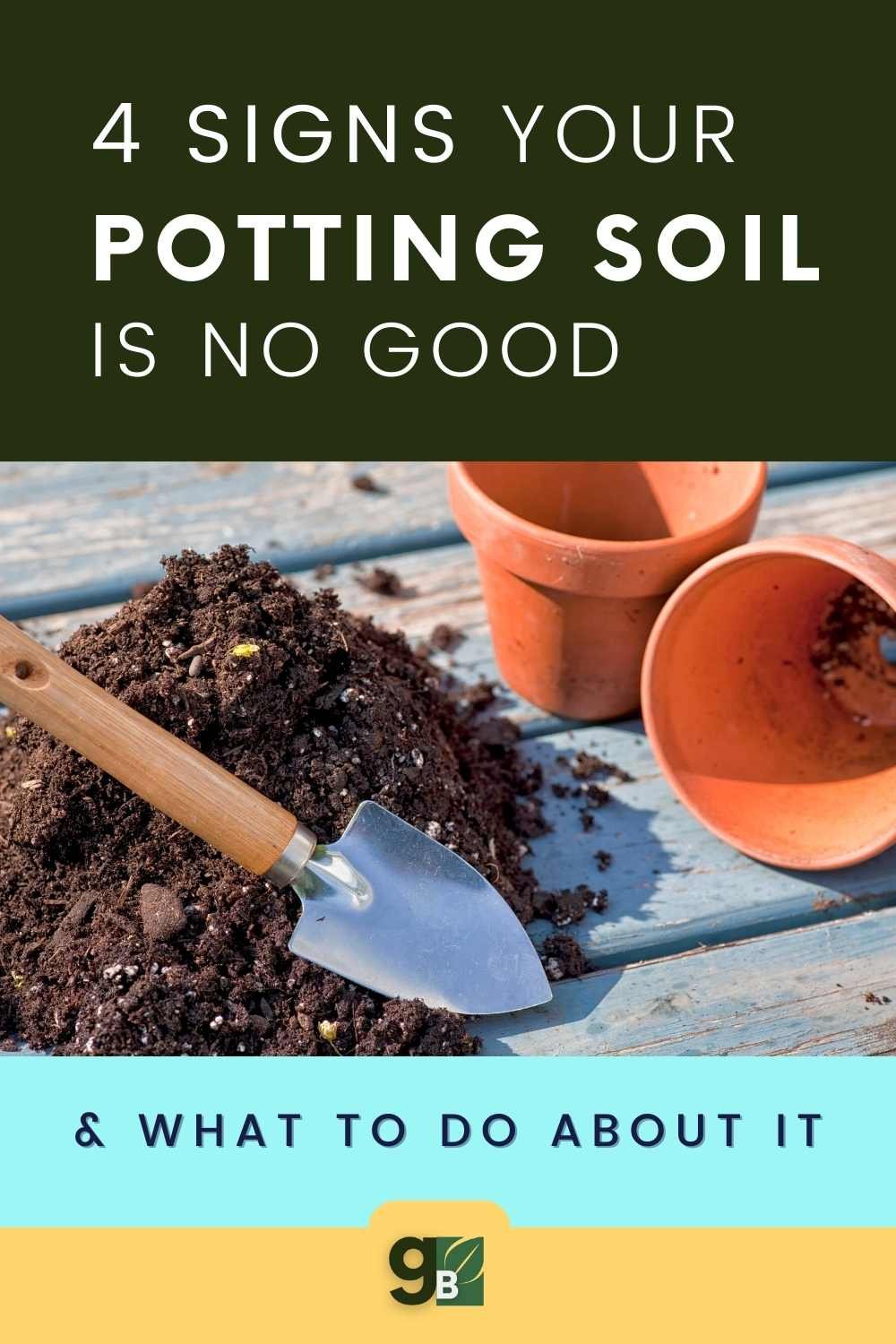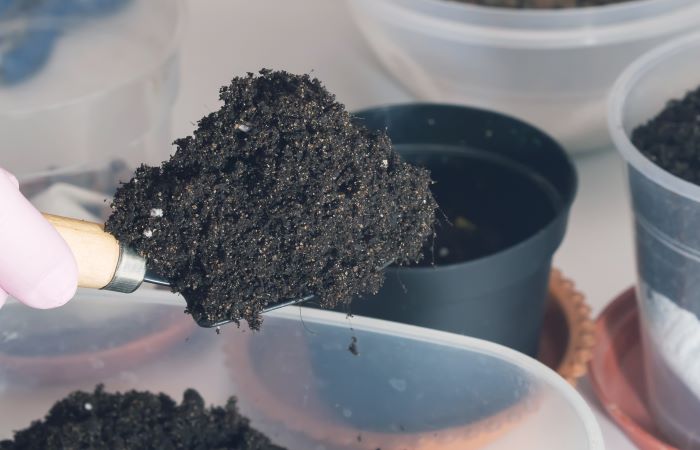To tell if potting soil is bad, check for any mold growth or foul odor.

Credit: www.gardenerbasics.com
How to Tell If Potting Soil is Bad: Step by Step Guide
Mold Growth And Foul Odor
Potting soil can go bad, and some signs indicate its unsuitability for plant growth. Mold growth is a clear indication of poor quality soil. When you see mold on the surface, it’s a red flag that your potting soil may be deteriorating.
Another sign to watch out for is a foul odor emanating from the soil. The presence of an unpleasant, musty smell suggests that the soil is spoiled. Additionally, check the texture of the soil when wet. If it feels slimy, it means the soil is retaining too much moisture, which can lead to root rot and hinder plant growth.
To ensure the health of your plants, monitor these indicators and consider replacing your potting soil if any of them are present. Remember, healthy soil is the foundation for thriving plants.
Poor Drainage And Compaction
Poor drainage and compaction are indicators of bad potting soil. Excessive water retention can lead to difficulty in draining excess water. When watering the plant, if the soil takes a long time to absorb the water or appears compacted and clumpy, it may be a sign of poor soil quality.
In such cases, the roots of the plants may not receive adequate oxygen, leading to root rot or other issues. Additionally, compacted soil hampers the growth of the plant’s root system, making it hard for the plant to establish itself properly.
To ensure healthy plant growth, it is essential to use high-quality potting soil that provides proper drainage and aeration for plant roots. Monitoring the soil’s performance and making necessary adjustments can help maintain optimal plant health.
Lack Of Nutrients And Poor Plant Growth
Potting soil can go bad if it lacks essential nutrients needed for healthy plant growth. Yellowing or stunted plants may indicate nutrient deficiency. Reduced foliage and flower production are also signs of poor soil quality. One common nutrient deficiency is chlorosis, where leaves turn yellow due to lack of chlorophyll.
Inspect the soil closely for any discoloration or unusual odor. Additionally, check for the presence of pests or diseases that could be affecting plant growth. It’s important to monitor the quality of your potting soil and make any necessary adjustments to provide your plants with the right conditions to thrive.
Remember, healthy soil leads to healthy plants.
Infestation Of Pests And Diseases
Infestation of pests and diseases can be a clear indication that your potting soil is bad. Presence of insects, grubs, or larvae suggests poor quality soil that may harm your plants. Additionally, an abundance of fungal diseases in the soil can hinder plant growth and cause damage.
Signs of rotting roots or any visible decay are also red flags that something is wrong with the potting soil. It is important to regularly check for these indicators to ensure that your plants have a healthy environment to grow in.

Having good quality potting soil is essential for successful gardening and thriving plants.
Depleted Organic Matter And Fertility
Depleted organic matter and fertility in potting soil can be identified by several signs. One indication is when the soil appears dry and lifeless, lacking moisture or any signs of activity. Another clue is inadequate decomposition of organic matter, which is a result of insufficient microbial activity.
This can be observed by the presence of undecomposed organic materials in the soil. Additionally, depleted organic matter leads to reduced soil fertility and nutrient content. The soil may lack necessary nutrients for plant growth, resulting in stunted or unhealthy plants.
To ensure the soil is not bad, it is important to regularly test the quality and fertility of potting soil. By addressing any issues promptly, gardeners can promote healthy plant growth and maximize their gardening efforts.
Ph Imbalance And Alkaline/Acidic Soil
Potting soil can go bad when there is a ph imbalance, resulting in either acidic or alkaline soil. The ph being too high or low can cause visible signs in plants, such as yellow leaves or stunted growth. Additionally, this imbalance can lead to difficulties in nutrient absorption by the plants.
It is important to monitor the ph levels of your potting soil to ensure optimal plant growth. So, keep an eye out for these signs and take necessary measures to restore the ph balance for your plants’ benefit. By maintaining a healthy ph, you can provide a conducive environment for your plants to thrive.
Remember, healthy soil equals healthy plants!
Weed Invasion And Invasive Species
Weed invasion and invasive species can indicate the quality of potting soil. Increased weed growth or weed seedlings are signs of a potential problem. Introduction of invasive plant species is another indication of a deteriorating soil condition. These invasive plants can take over and compete with other plants for resources such as water, nutrients, and space.
If you notice these indications, it may be time to assess the quality of your potting soil and take necessary steps to improve it. Keeping an eye out for the presence of weeds and invasive species helps maintain a healthy and thriving garden.
Regular monitoring and appropriate measures can prevent further deterioration of the potting soil and ensure successful growth of desired plants.
Poor Soil Texture And Drainage Issues
Potting soil can go bad due to poor texture and drainage issues, such as sandy or clay-like texture. These textures cause soil particles to easily break apart. Consequently, such soil types fail to absorb water or retain moisture effectively. Such complications affect the overall quality and health of the plants grown in such soil.

Therefore, it is crucial to be able to identify these issues to prevent plant growth problems. By checking the texture and observing the soil’s ability to absorb water, one can determine if the potting soil is bad. Regularly monitoring and maintaining the quality of potting soil is essential for successful gardening outcomes.
Expiry Date And Shelf Life
Check the expiration date of the potting soil and consider the shelf life of opened bags. Soil loses effectiveness over time. Potting soil may go bad if it has surpassed its expiry date or if it has been stored for an extended period.
Expired potting soil can become compacted, hard, and difficult to rehydrate. It may also develop a foul odor or harbor pests and diseases. To determine if your potting soil is still good, examine the packaging for an expiration date. If it is past the date, it’s best to discard it.
However, even if the expiration date hasn’t passed, opened bags of potting soil have a shorter shelf life. Over time, the soil quality may deteriorate, affecting its ability to provide nutrients and support plant growth. Always check the quality of your potting soil before using it for your plants’ health and well-being.
Frequently Asked Questions Of How To Tell If Potting Soil Is Bad
How Can I Tell If Potting Soil Is Bad?
If potting soil has a foul odor or moldy appearance, it is likely bad. Also, if the soil feels excessively moist or has a gnats infestation, these are signs of poor quality. Additionally, check for any signs of plant diseases or stunted growth when using potting soil.
Can Expired Potting Soil Be Used?
Expired potting soil can still be used if it has been stored properly and doesn’t exhibit any signs of deterioration. However, it may have a reduced nutrient content, so it’s advisable to mix it with fresh soil or amend it with organic matter for better plant growth.
How Long Does Potting Soil Last?
The lifespan of potting soil varies depending on factors like storage conditions and quality. Typically, if stored correctly, potting soil can last for 1 to 2 years. However, it’s best to check for any signs of spoilage such as odor, mold, or excessive moisture before using it.
Can I Reuse Old Potting Soil?
Yes, you can reuse old potting soil. Before reusing, remove any plant debris and loosen the soil. To refresh it, you can mix in compost or organic matter to improve its nutrient content. However, avoid reusing soil that has had diseased plants to prevent the spread of pathogens.
What Should I Do If My Potting Soil Is Bad?
If your potting soil is bad, it’s best to dispose of it to avoid potential issues with plant health. Avoid using it for new plants or seedlings, as it may hinder their growth. Consider using fresh potting soil to ensure optimal conditions for your plants’ health and growth.
Conclusion
Identifying bad potting soil is crucial for the successful growth of your plants. By paying attention to the color, texture, and smell of the soil, as well as considering any signs of mold, pests, or disease, you can determine whether it is suitable for use.
Testing the soil’s moisture content and ph level further aids in evaluating its quality. Remember to avoid using soil that is clumpy, foul-smelling, or infested with insects. Choosing the right potting soil is essential for the health and vitality of your plants.
By following these guidelines, you can ensure that your plants have the best chance of flourishing. Taking the time to assess the quality of your potting soil will result in thriving plants and a happy, successful gardening experience.

